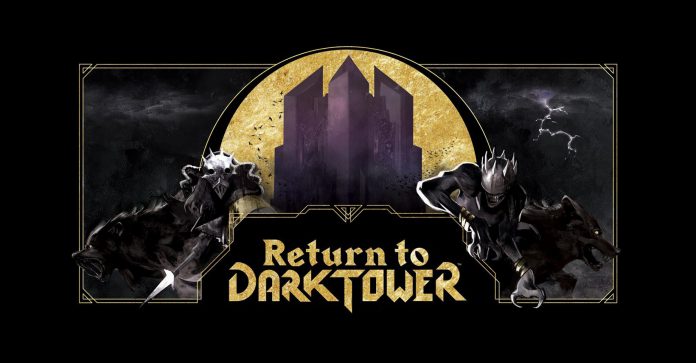I have huge admiration for what Restoration Games is doing. The company is based on pulling old out-of-print board games out of the annals of history. They’re given a fresh coat of paint, some updated rules, and born with new life. They’re all pretty damned good too.
We’ve covered Unmatched in the past which has become an evergreen tentpole game line for them. Downforce is another excellent game in their catalog that I’m always happy to play or recommend. Both of these games were released through traditional distributor models, as are most of these Restoration Projects. Occasionally, however, Restoration Games dusts off an epic game from time long ago and gives it a deluxe treatment using Kickstarter.
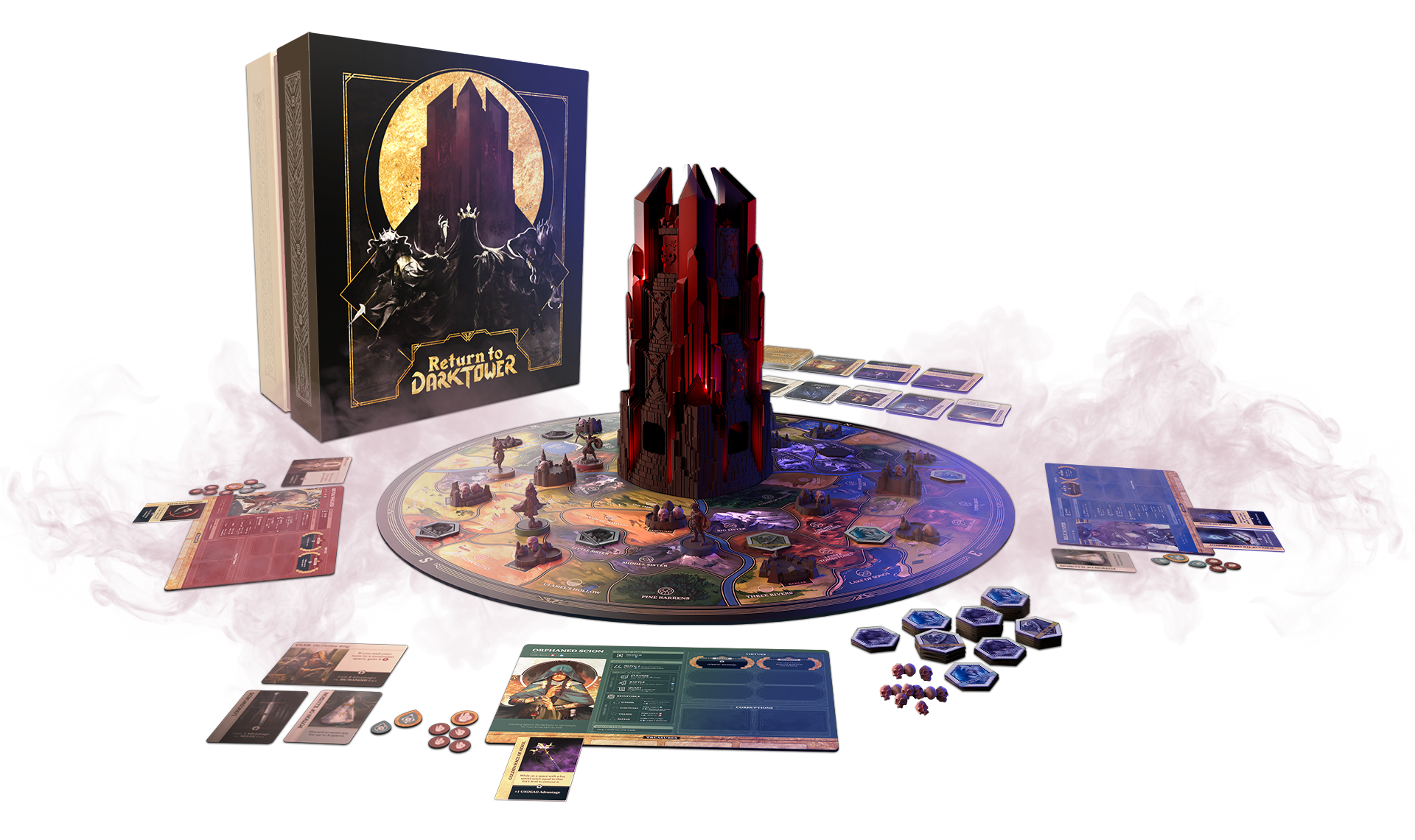
Following in Fireball Island’s massive, kinetic, plastic footprint comes Return to Dark Tower. Fans of the original may remember an oppressive digital tower controlling dragons and dark enemies. The return is similar, though this new design makes it fully cooperative with a competitive mode added as an option. I backed this one myself; I don’t have any history with the original but it’s exciting to watch a company swing for the fences.
On its surface, Return to Dark Tower feels like a dungeon crawler. Your character will travel around the massive circular board fighting skeletons and dragons, spelunking caves and dungeons, and growing in power via new abilities and treasure. It plays, however, like a threat-mitigation cooperative game like Pandemic. Given that the two lead designers are responsible for Gloomhaven and Pandemic Legacy (BGG’s #1 and #2 games of all time), this fits.
And it fits well. Structurally, games of Dark Tower begin similarly. You’ll have a primary scenario that sets the narrative. Maybe you’re trying to recover lost treasures said to be the key to destroying the tower. Alternatively you could be traveling the countryside raising a massive army for a direct assault. There’s also a Big Bad Evil Monster to contend with. This ranges from sinister humans to flame-wreathed monsters to an all-consuming sentient rot. Finally, there are the “normal” monsters that fill the land throughout the game, moving and striking at your characters.
While the narrative is different, the structure is similar. Your main scenario will have a Quest associated with it. Once you’ve acquired or meet the necessary prerequisites you can activate the Quest in the appropriate space, spawning the Big Bad. Defeat this powerful monster in combat and you win.
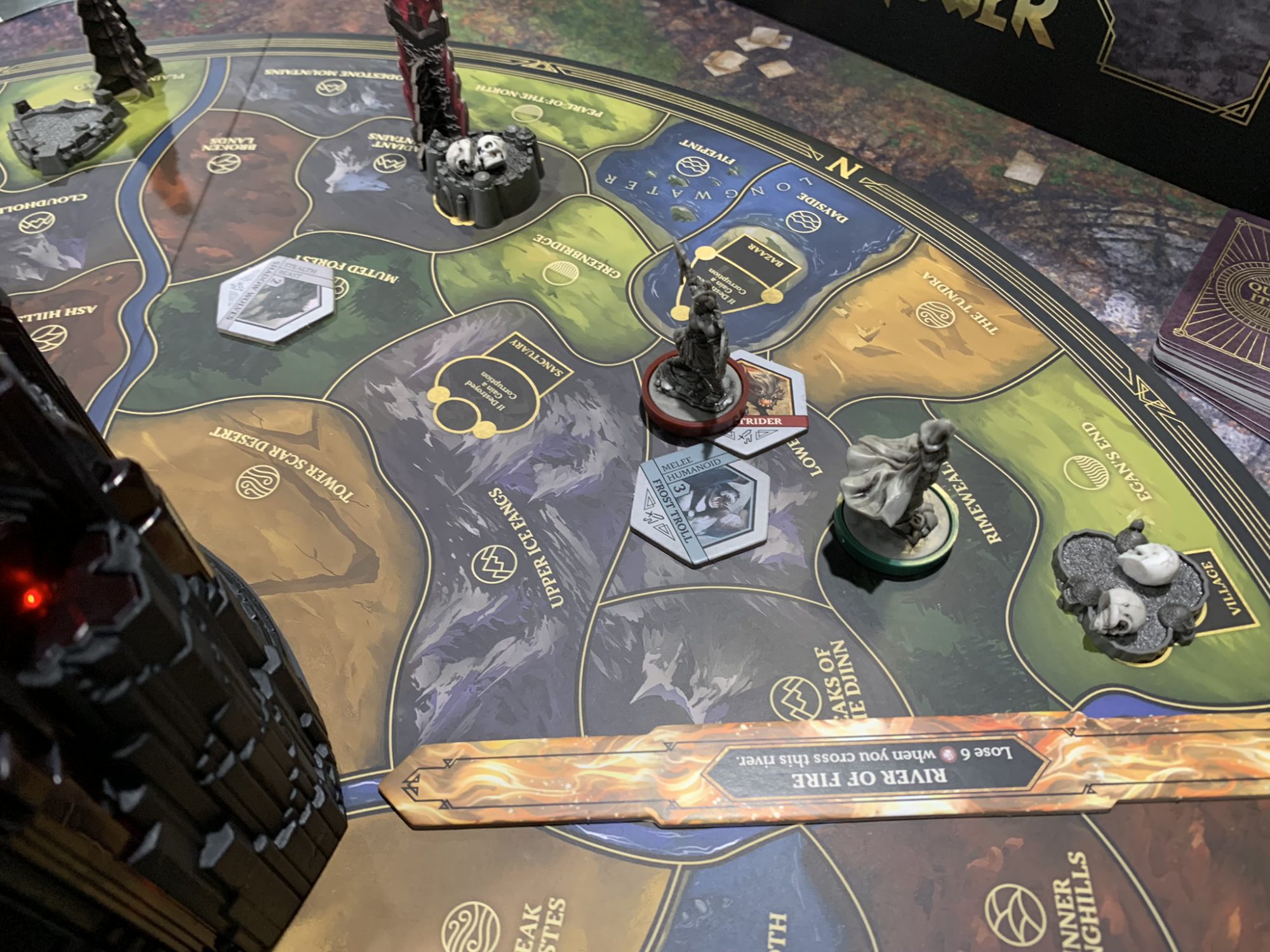
Fail to complete this in 6 months however, and you lose. You can also lose if your character falls to corruption. Or if you don’t Cleanse the realm of evil, represented by small plastic skulls that come tumbling out of the massive Tower. They’ll accumulate on buildings that are destroyed if you don’t remove them (also spreading corruption to your character).
And so you’re off, fighting monsters and exploring dungeons while trying to manage those damn skulls. I like this hybrid threat-management and dungeon feel. The character growth is satisfying but the game does not bog down in tactical movement. Turns are snappy, with strategy being dominated by the balance of personal character growth and board management.
I do wish the narrative was a little more explicit. While flavor text is not necessarily the best way to provide narrative, there is very little of even that. This particularly impacts combat to the point of not feeling like combat. Monsters attack and vice versa, with the effect of losing resources, but the loss of warriors vs spirit vs items isn’t explained within the fantasy.
The overall vibe though, is excellent. Over time, the board state degrades as more powerful monsters show up. Skulls begin to litter every building on the board and you’re pressed. Take the time to clear them and time runs out. Focus on acquiring treasure and you may end up the powerful leader of a failed and dead kingdom. Either way, stands the giant Dark Tower itself casting its shadow over everything.
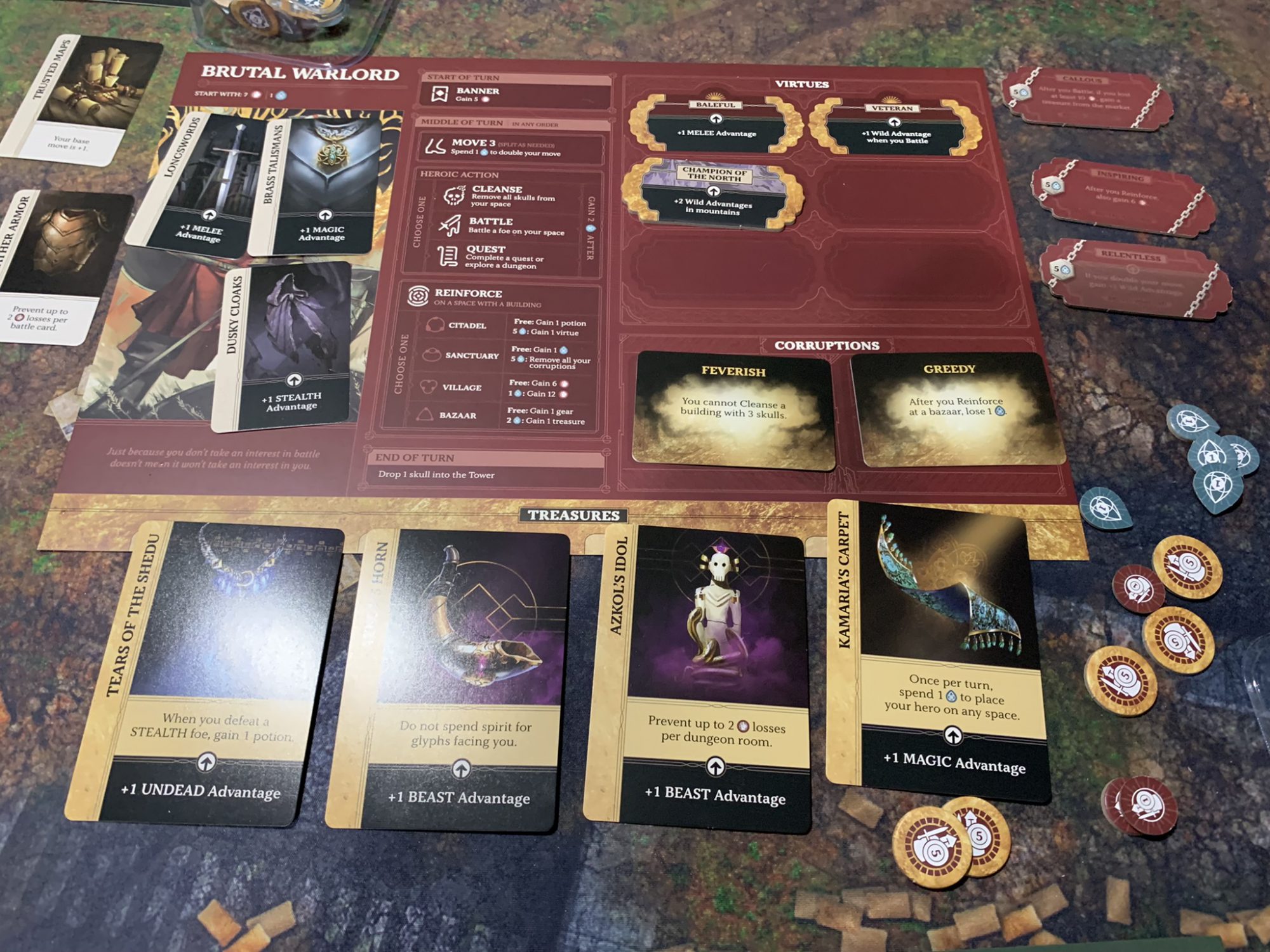
“Daddy, why is it screaming?”
I’m not typically one for game unboxings. I have opened, punched, and sorted hundreds of board games. I care about the game, not the stuff. From tiny microgames to giant miniatures-filled Kickstarters, no game has ever struck me as immediately upon opening the box as Return to Dark Tower.
Everything is stunning. The double-sided foil embossed box, the eponymous Tower that is weighty enough to use as a weapon, it’s all grand. And ominous. After getting everything ready to play and firing up the Tower, I ran it through some audio tests just to see what it sounded like. It was at the moment when my 6 year old gave me a scared look and asked why the tower was screaming that I knew that—if nothing else—Restoration Games had nailed the ambiance.
The tower grounds it all. It stands tall. It looms as a hefty hunk of plastic, metal, and LEDs emanating all manner of whirs, lights, and screams. Thanks to its bluetooth capabilities, it also reacts as stuff happens in the app. Slay a monster, abandon a dungeon, or simply advance your turn and the tower will pulse and shriek appropriately (wait for it).
To signify the end of your turn you drop a small plastic skull into the tower. Again the tower pulses and stuff (probably) happens in the app as it marks the next players turn and doles out good or bad events. The skull then becomes part of the game as it tumbles out on to the board like you’ve just engaged with a demonic dice tower. Except for when it doesn’t…and that’s worse.
Inside the tower is some byzantine labyrinth of openings and passages that will direct each skull towards one of the openings. Because most of the openings begin the game closed by a plastic seal, these skulls can linger—and accumulate—behind a door until the app directs you to unseal a doorway. This can cause those trapped skulls to fall, and when 2 or 3 come tumbling out it can spell rapid doom for one of the Kingdoms and dramatically alter your plans.
All of this is hidden from the players. You will hear the clatter of the skull as it falls through 4 levels of tower. You’ll hear the whir as the three rotating levels change position through the game, possibly hearing yet another clatter as a skull moves from here to there. But there is no way to know where it has landed, no way to know what waits when you open that seal.
To put it clearly, it is the most advanced and atmospheric gaming component on the market. Which is why, counterintuitively, I’m surprised at how muted the impact is on the threat mechanisms themselves.
Yes, the skulls clatter out periodically risking the loss of important buildings and acting as a timer. And yes, the exposed glyphs will set your turns back just a little, but for the most part the tower just sits there. Screaming. Looming. You can’t ignore it. You can’t do anything about it. Fantastically, it grabs your attention yet somehow feels subtle.
The app, on the other hand, can dominate play.
A Deadly Balance
App-assisted board games have to strike a difficult balance. If the app doesn’t provide enough to the game, you’re left wondering why they bothered. Too much on the other hand, and you’re left feeling like you’re playing a video game with cardboard upkeep…again why bother. Whether or not you enjoy Dark Tower is going to depend on how you get on with the app.
Like the tower, the app is technically fantastic. It’s clean, easy to understand, and adds to the ambiance with music and noise. This is good, because you’ll spend quite a bit of time interacting with it.
From the get go, you’ll have to let the app know some gameplay basics. Difficulty, player count, adventure, monsters, etc get fed into the app during setup so that the app can in turn direct where they spawn. It also controls the semi-random number of turns per month and acts as the narrative engine.
About half of what the app does is great. In an old school dungeon crawler or co-op game you’d be consulting tables or drawing cards out of a number of decks. The app handles all that seamlessly and—more importantly—dynamically. It knows if you’ve ignored a certain monster and preferentially makes them more aggressive and stronger. It helps the growing evil feel living and breathing.
The other half is where some groups may find frustration. Combat and dungeon exploration are both handled entirely through the app. The use of the app enables some clever new mechanisms that I enjoy. For example, combat is handled by selecting a number of cards from the creature’s battle deck. The app could just deal them randomly but there is a scary feeling of controlling your own fate when you’re forced to select them yourself.
Combat is then a press-your-luck exercise in spending Advantages you’ve accumulated. Each creature has 1 or 2 Traits like Humanoid, Undead, or Stealth. Your characters will gain advantages based on their inherent abilities and items they’ve gathered. Advantages are then spent in combat to downgrade the battle cards you’ve been presented. This gif might help:

Each card begins with a list of the penalties you’ll take for resolving it. Each Advantage you spend on a card downgrades those penalties. Downgrade it enough and you might even turn the penalty into a boon. If you’re able to resolve each battle card you win and defeat the enemy. Advantages can be permanent or temporary based on their source and are the main form of character progression.
Dungeons work similarly. Each dungeon has a Trait and you can use Advantages to downgrade each room you move through. The dungeon itself is presented in the app as a map that you select your path. You’ll move room by room until you either find the final room or leave to pick back up your exploration on a future turn. Again, a gif:
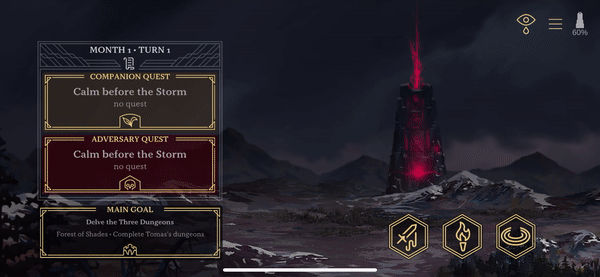
I like this system broadly speaking. Downgrading cards (permanently, in the case of the final boss) is a system that would be clunky outside of an app, and the ability to explore dungeons adds to the hybrid feel that shines in Dark Tower. The catch is that a lot of important time is spent looking at your phone or tablet and not at the board. All of the combat and all of the exploration occurs in your device, not on the table.
The effect to the table is just the removal or persistence of a small cardboard token. I can’t say if this will work for you or your group, but in my experience it leads to a lot of quiet time. When someone goes into battle they grab the device and make their choices privately, maybe asking for some input but often just doing their thing. There is also (baffingly) no flavor text or narrative at all, just a presentation of impact to your resources.
I think the best way to play (if you have the set-up) is to screen mirror your phone onto a TV in the gaming area, so at least other players can read along or see your dungeon map developing. Not everyone has this though, so your experience with the digital element will vary.
What’s Old is New
Restoration Games has emerged as one of the most consistent publishers on the market. While I’m not familiar with all of the original titles they restore, their newer updated versions tend to find homes on my shelf. Return to Dark Tower is a large impressive production—with a price tag to match. I can’t begin to imagine the amount of engineering went into the Tower and the app, but I’m glad there’s a company out there taking these swings.
Overall, this update feels fresh. Dungeon crawlers are often cooperative but they are a different sort of cooperative; you’re exploring a narrative. The opposite is true for traditional co-ops. Return to Dark Tower feels like an innovative merging of worlds. Whether or not it’s a home run for you will likely depend on your relationship with board game apps. As for me? I’m questing for a large space on my shelf.
